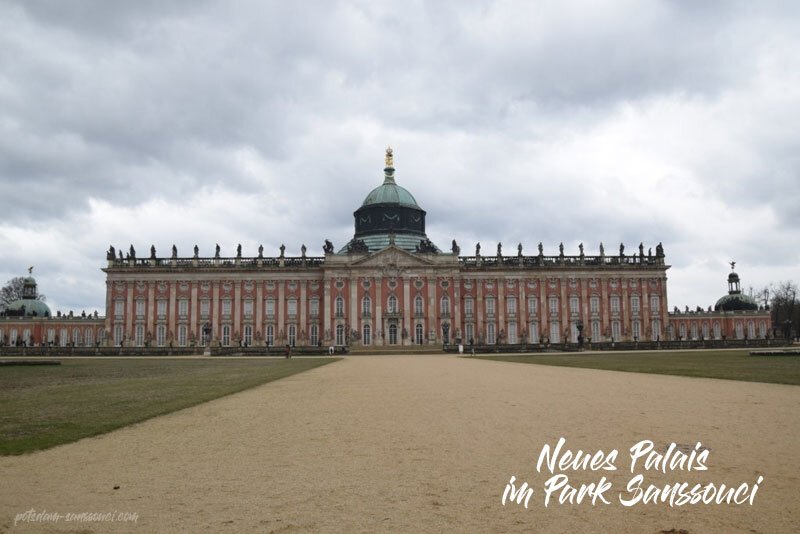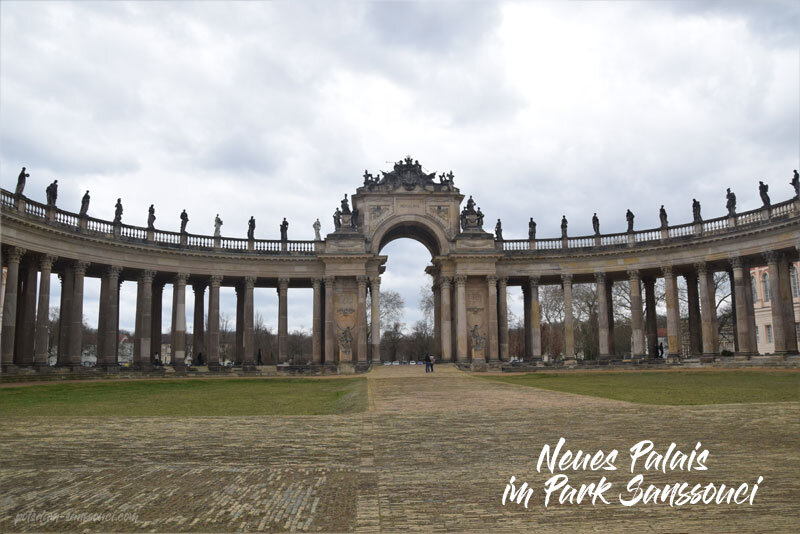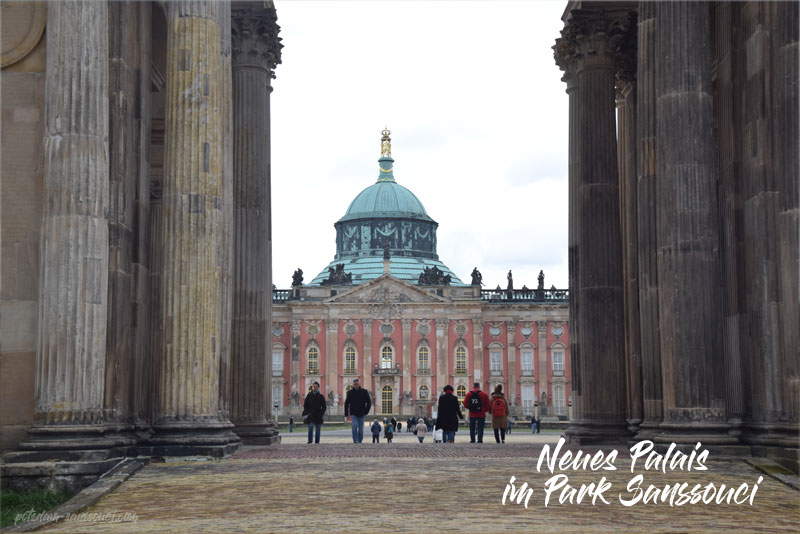
New Palace in Sanssouci Park – Frederick’s last creation
The New Palace is located on the west side of Sanssouci Park and is one of the park’s great attractions. In this article we would like to introduce you to the baroque palace.
| The Sanssouci+ ticket is valid for 11 castles, including the New Palace
|
Frederick’s last creation in Sanssouci Park in Potsdam
The so-called “Fanfaronade” was built between 1763 and 1769 on the occasion of the Prussian Seven Years War. Builders for Frederick the Great included Gottfried Büring, Heinrich-Ludwig Manger and Carl von Gontard. The beautiful Rococo building stands in the west and forms the end of the park here. The drum dome with the gilded figures of the Three Graces, who wear the Prussian crown on a cushion, can already be seen from a distance. The castle was Frederick’s last creation.
“Fanfaronade” – Fredericks summer house
It is the largest castle in the park with numerous outbuildings. However, Frederick’s last creation is not a main palace for the king, but a palace for his guests.
„maison de plaisance, a summer house“
King Frederick II of Prussia only used the castle for short summer stays. During this time he received his relatives from the German and European royal houses. The rest of the year the castle was empty.
The name “Fanfaronade” (boasting, showing off, trumpeting around), as Frederick himself called the castle, also explains the reason for the building. The New Palais is too
„to be understood as a demonstration of the economic and intellectual potency of Prussia after a war against all of Europe“ (Dr. Alfred Hagemann, © 2011, damals.de).
But the castle had one more purpose – it was opened to visitors. And it still is today. It was not until Kaiser Wilhelm II later made it his summer residence.
New Palace – Germany’s largest baroque palace
The New Palace was commissioned by King Frederick in the first half of the 1750s. The building plans were drawn up by Büring and Manger on the basis of sketches by King Frederick. Originally, the palace was to be built on the southern axis of Sanssouci Palace on the Havel. The Seven Years War changed the plans. On the one hand, the start of construction was delayed and, on the other hand, the palace was relocated to the western end of the park’s main avenue.
The inauguration of the castle took place on July 19, 1768. It was later supplemented by numerous extensions. Today communes, farm buildings, side wings, coach houses, colonnades and a triumphal gate belong to the palace complex. The completion is therefore dated to the year 1769.
Architecture of New Palace
The New Palace is a baroque palace and consists of a three-winged corps de logis (residential wing) around a courtyard with low side wings. The three-wing system has a front length of 220 meters. The facade is characterized by a reddish brick pattern and fluted Corinthian pilasters made of sandstone in colossal order. The red brick was only painted on for cost reasons.
Opposite are two communs. These farm buildings were connected by an underground corridor and were used to accommodate the servants, kitchens, entourage of guests and the court administration. They are also connected by a semicircular colonnade. They form the splendid conclusion of the park.
„Originally, the Communs were also supposed to block the view of the swamps behind the park.“
The middle section of the two-and-a-half-storey building – with a mezzanine – is crowned by a huge, functionless 55 meter high main dome. The Three Graces group is located on the dome. The dome is only used for architectural decoration and has no other purpose. It does not contain any space.
The two single-storey pavilion-like side wings have an L-shaped floor plan. They also each have a dome.
Over 400 large figures and sculptures are placed on the balustrades and on the pilaster pedestals, depicting scenes and figures (gods and demigods) from ancient mythology. Several sculptors and dozens of stonemasons worked on it for six years.
Rooms of the New Palace
Due to its size, the palace contains several rooms and halls. The building has more than two hundred rooms. There are over 300 paintings by Italian, Dutch and French artists.
In the middle of the building there are two ballrooms one above the other. Galleries are connected to the garden side in the south. These lead to the royal apartment on the ground floor and to the rooms of the Prince of Prussia on the first floor. There are also two apartments on the front of the courtyard.
The southern side wing facing the Communs houses the palace theater on the upper floor. Underneath are guest rooms.
The princely quarters, which were used for receptions, connect to the central halls in the north. The high northern side wing was used by the siblings Prince Heinrich and Princess Amalie. The low north wing was used to accommodate the escorted ladies and gentlemen of the guests.
Later there were some conversions, modernizations and conversions of rooms. So, for example, Frederick Wilhelm III. a private apartment in the apartment of the Prince of Prussia. Further changes followed each time the user changed.
In summary, the New Palais houses the following rooms:
- Vestibule and grotto or shell hall
- Marble gallery
- King’s apartment with bedroom, writing cabinet, library
- Concert room
- Princely quarters
- Red damask chamber, bar room, oval cabinet
- Apartment of the Prince of Prussia
- Marble Hall and Upper Gallery
- Castle theater
Vestibule and grotto or shell hall
As a visitor, you first enter the vestibule. Then you come to the grotto or shell hall.
Over 20,000 different minerals, ores, fossils, shells and snails, rocks and artefacts adorn and decorate the garden room designed as a grotto. The hall was originally designed a little more simply, but the walls were further enriched with minerals, fossils and semi-precious stones in the 19th century.
The Tamerlanzimmer, which got its name from the wall-filling painting (by Andrea Celestis) in it, adjoins the “Grottensaal”.

Marble gallery, blue chamber and concert room
The marble gallery, flooded with light due to its position to the east towards the park, borders the grotto or shell hall to the east. It leads to the blue chamber. This painting cabinet probably served as a waiting room and lounge, for example to wait for a concert. The concert room adjoins the Blue Chamber. This was based on the concert room in Sanssouci Palace.
Royal apartment with bedroom, pink chamber, writing cabinet, library
The king’s apartment is adjacent to the music room and includes a bedroom, pink chamber, writing cabinet and library. There is also a small dining room and a small reading cabinet. The apartment, including the furniture, was completed in autumn 1765.
Princely quarters
The two princely quarters lay one above the other in the northern residential wing and were accessible via separate stairwells. Three large rooms were intended for public use, followed by a concert room and a small cabinet. There are also private rooms. These included anteroom, painting and writing cabinets, rest rooms and bedrooms.
Apartment of the Prince of Prussia
The apartment of the Prince of Prussia was above the royal apartment. It consisted of only three rooms and, considering the size of the castle, was very small in terms of area. It consisted of an anteroom, a bedroom and a cabinet.
Marble Hall and Upper Gallery
The marble hall is the main hall and goes back to an idea by Carl von Gontard. It resembles the marble hall of the Potsdam City Palace. It lies above the grotto or shell hall and was designed for the presentation of large-format paintings. The large wall surfaces are structured by Corinthian pilasters. The floor is made of native marble from the rich Silesian deposits. The ceiling is adorned with a large ceiling painting by Amédée van Loo: “Gods meal with the introduction of Ganymede to Olympus”.
To the south of the Marble Hall is the Upper Gallery, which is furnished with six large wall paintings of Italian Baroque painting.
Palace Theater in the New Palace
The castle theater is one of the most beautiful still preserved theater rooms from the 18th century. It was realized in the form of an amphitheater. There was also no royal box. Frederick is said to have sat in the front row himself.
In 1832 Felix Mendelssohn’s Bartholdy’s music for “A Midsummer Night’s Dream” was premiered here in the theater.

Red damask chamber, bar room, oval cabinet
The New Palace also has a large number of other rooms. The red damask chamber, the bar room and the oval cabinet should be mentioned in particular. All rooms have unique features, are decorated with paintings or have special furnishings.
Address
Am Neuen Palais, 14469 Potsdam
Tickets
| The Sanssouci+ ticket is valid for 11 castles, including the New Palace
|
| About this activity | Book now / informations |
|---|---|
| Tickets | |
combination ticket sanssouci+ The combination ticket sanssouci+ allows for a one-time visit to all* open palaces of the Prussian Palaces and Gardens Foundation Berlin-Brandenburg in Potsdam, including Sanssouci Palace, on a single day. (Starting from €17 per person, GetYourGuide, free cancellation up to 24 hours before the start.) | |
Potsdam: Sanssouci Palace Guided Tour from Berlin  Experience the gardens and majestic architecture of the Sanssouci Park on this tour from Berlin. Explore the highlights of Potsdam, the Sanssouci's palace, and the beautiful Peace Church. (From € 54 per person, GetYourGuide)) Experience the gardens and majestic architecture of the Sanssouci Park on this tour from Berlin. Explore the highlights of Potsdam, the Sanssouci's palace, and the beautiful Peace Church. (From € 54 per person, GetYourGuide)) | |
| Guide Tours | |
Berlin: Potsdam - Kings, Gardens & Palaces 6-Hour Tour Explore the city of Potsdam with a English-speaking guide on a half-day tour of its picturesque palaces, lakes and gardens. Steeped in history, from Frederick the Great to Churchill, Truman and Stalin, you will take a trip back in time. (From 28,90 € per Person, GetYourGuide) | |
Potsdam: Private Sanssouci Palace Walking Tour Visit Potsdam on a private walking tour through the over 1,000-year-old city center and stroll through the manicured gardens of the historical Sanssouci Palace. (From € 195 per group up to 30, GetYourGuide). | |
From Berlin: Potsdam & Sanssouci City of German Kings Tour Explore one of the most beautiful and interesting places in Germany, Sanssouci, with its large palaces and gardens. Hear the fascinating story of how Germany and Prussia came into being. Appreciate the architecture as your guide takes you around Potsdam. (From € 290 per group up to 6, GetYourGuide) | |
From Berlin: Potsdam Private Guided Tour in English Explore the former royal residence of the Prussian kings on a private 6-hour tour of Potsdam from Berlin. See the UNESCO World Heritage palaces and parks, and learn the city’s history from your guide. Go to the Marble Palace, Schloss Cecilienhof, and more. (From € 960 per group up to 6, GetYourGuide) | |
Gardens & Palaces of Potsdam Bike Tour from Berlin Potsdam is Berlin’s most popular destination for day trips and a playground for a bicyclist, with many Prussian and Cold War sights tucked deep in verdant parks and along quiet alleyways. On this 6.5-hour tour from Berlin, explore Potsdam’s many sights. (From € 75 per person, GetYourGuide) | |
From Berlin: Potsdam city tour of the emperors The former capital of the Kingdom of Prussia, Potsdam's baroque parks and palaces, have received the status of a UNESCO World Heritage Site. Explore the city with a guide on this small-group tour by train from Berlin. Hear about emperors, kings, and World War II. Stroll through ornate streets and Sanssouci Park. and skip the long lines for Sanssouci Palace itself. Please note: Entrance fees and train tickets are at your own expense. (from € 50.00, Viator) | |
Private half-day walking tour of Potsdam and Sanssouci Palace Explore the former seat of the Prussian kings on this private half-day tour of Potsdam, including the magnificent Sanssouci Palace. Follow your guide through Potsdam's old town, stopping to snap photos of the Brandenburg Gate. Stroll through the opulent City Palace and admire the red brick buildings of the Dutch Quarter. Then admire the UNESCO World Heritage Site Sanssouci Palace and explore the palace gardens, the Chinese tea house, and the tomb of the Prussian King Frederick the Great. (from € 190.00 per group (up to 10), Viator) | |
Berlin: Sachsenhausen Concentration Camp and Potsdam Tour Discover two of the most iconic sights of the Berlin area on the only tour with transport included. Take a guided tour of the Sachsenhausen Memorial and enjoy a tour of the historic city of Potsdam. (From € 49 per person, GetYourGuide, Reserve now and pay later to book your spot and pay nothing today) | |
Potsdam: Sanssouci Park Self-Guided Gardens Audio Tour Find out what made Potsdam’s Little Versaille so special to several former kings on this self-guided audio tour. Walk around the garden's landmarks and experience the magic of GPS playback. (From 5,43 € per person) | |
| Sightseeing Tours & Boat Cruises | |
Potsdam: City and Castles Tour  Enjoy a fun city tour of the highlights of Potsdam and visit the fascinating castles of Sanssouci, Cecilienhof and the New Palace. Stroll through the Baroque old town and walk in the footsteps of "Old Fritz". (From € 25 per person, GetYourGuide, Bestseller) Enjoy a fun city tour of the highlights of Potsdam and visit the fascinating castles of Sanssouci, Cecilienhof and the New Palace. Stroll through the Baroque old town and walk in the footsteps of "Old Fritz". (From € 25 per person, GetYourGuide, Bestseller) | |
Potsdam: 1-day ticket for the hop-on / hop-off bus tour  Discover Potsdam at your own pace with a 1-day ticket for the hop-on and hop-off sightseeing bus tour. Get live commentary as the bus travels past the main sights and attractions, and jump off at any of the 12 stops. (From € 20 per person, GetYourGuide) Discover Potsdam at your own pace with a 1-day ticket for the hop-on and hop-off sightseeing bus tour. Get live commentary as the bus travels past the main sights and attractions, and jump off at any of the 12 stops. (From € 20 per person, GetYourGuide) | |
Potsdam: Palace Tour by Boat  See the most beautiful sights of Potsdam and discover the hill landscape from the water in only 90 minutes. Admire the countless palaces and wonderful parks from the Hohenzollern Dynasty and see a true piece of history. (From € 22 per person, GetYourGuide) See the most beautiful sights of Potsdam and discover the hill landscape from the water in only 90 minutes. Admire the countless palaces and wonderful parks from the Hohenzollern Dynasty and see a true piece of history. (From € 22 per person, GetYourGuide) | |
Potsdam by Boat: Island Cruise  Discover all of Potsdam on this very special boat trip and explore the unique riverscape surrounded by impressive manor houses and magnificent buildings. Admire Caputh Castle, Babelsberg Castle and other beautiful sights. (From € 36 per person, GetYourGuide) Discover all of Potsdam on this very special boat trip and explore the unique riverscape surrounded by impressive manor houses and magnificent buildings. Admire Caputh Castle, Babelsberg Castle and other beautiful sights. (From € 36 per person, GetYourGuide) | |
| Events | |
Potsdamer Schlössernacht in Sanssouci Park ++ Potsdamer Schlössernacht ++ One of the special highlights is the Potsdamer Schlössernacht in Sanssouci Park in Potsdam. The annual two-day event attracts thousands of visitors to Potsdam every year. Tickets are now available from Eventim. | |
| City Cards | |
Potsdam & Berlin WelcomeCard:   Explore Berlin with a 2, 3, 4, 5, or 6-day Berlin WelcomeCard. Ride public transport in the ABC zones, including Berlin Brandenburg Airport, receive discounts of up to 50% with many partners, and benefit from the pocket travel guide. (From € 24 per person, GetYourGuide) Explore Berlin with a 2, 3, 4, 5, or 6-day Berlin WelcomeCard. Ride public transport in the ABC zones, including Berlin Brandenburg Airport, receive discounts of up to 50% with many partners, and benefit from the pocket travel guide. (From € 24 per person, GetYourGuide) | |
| Tip: With GetYourGuide you can cancel booked activities up to 24 hours before the start and receive a full refund. | |
| Note: Avoid purchasing tickets on the black market. Our ticket partners are exclusively verified vendors. | |
opening hours
The opening hours for the winter season from November to March (01.11.2023 – 31.03.2024) are Mondays from 10:00 AM to 4:30 PM, closed on Tuesdays, and from Wednesday to Sunday from 10:00 AM to 4:30 PM. On New Year’s Eve (31.12.2023), the venue is open from 10:00 AM to 2:00 PM, and on New Year’s Day (01.01.2024) from 11:00 AM to 4:30 PM.
For the summer season from April to October (01.04.2024 – 31.10.2024), the hours are Mondays from 10:00 AM to 5:30 PM, closed on Tuesdays, and from Wednesday to Sunday from 10:00 AM to 5:30 PM. The venue is closed on the days of the staff meetings on 10.04.2024 and 16.10.2024.
Last admission 30 minutes before closing time.
References:
- Potsdam-Lexikon (2010): Stadtgeschichte von A bis Z / im Auftr. des Hauses der Brandenburgisch-Preußischen Geschichte und der Landeshauptstadt Potsdam, Potsdam-Museum – Forum für Kunst und Geschichte: Berlin : vbb, Verl. für Berlin-Brandenburg.
- MARCO POLO Reiseführer Potsdam mit Umgebung (2015) / Bernd Wurlitzer ; Kerstin Sucher, 11. Auflage: Ostfildern : Marco Polo / Mairdumont.
- Das Neue Palais von Sanssouci (2018) / Text: Henriette Graf ; Stiftung Preussische Schlösser und Gärten Berlin-Brandenburg: Berlin ; München : Deutscher Kunstverlag.
- https://de.wikipedia.org/wiki/Neues_Palais (abgerufen 11.05.2020)
- https://www.wissenschaft.de/magazin/weitere-themen/Fredericks-gebaute-fanfaronade/ (abgerufen 11.05.2020)









